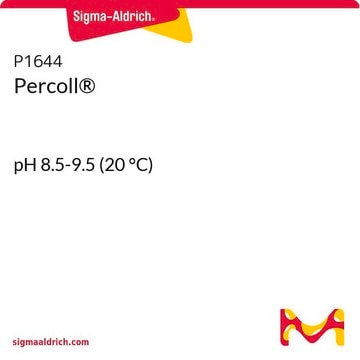2160
Autofluorescence Eliminator Reagent
Autofluorescence Eliminator Reagent for IHC.
Sinônimo(s):
fluorescence IHC counter stain
Faça loginpara ver os preços organizacionais e de contrato
About This Item
Código UNSPSC:
41116010
eCl@ss:
42029053
Produtos recomendados
forma
liquid
embalagem
pkg of 50 mL
fabricante/nome comercial
Chemicon®
técnica(s)
immunohistochemistry: suitable
Condições de expedição
ambient
Descrição geral
Ready-to-use for application in fluorescence microscopy procedures. With increasing age, the autofluorescent pigment lipofuscin accumulates in the cytoplasm of many cell types, including neurons. The presence of lipofuscin granules can complicate the use of fluorescence microscopy in the central nervous system because of its broad excitation and emission spectra, which overlaps with those of most commonly used fluorophores. The Autofluorescence Eliminator Reagent will reduce or eliminate lipofuscin-like autofluorescence without adversely affecting other fluorescent label in sections of human, monkey or rat neural tissue as well as other tissues.
Aplicação
Fluorescence immunohistochemistry counterstain.
PROTOCOL:
1.After immunofluorescence histochemistry, the sections are immersed in PBS for 5 min.·
2.Sections are immersed in 70% ethanol for 5 min.·
3.Sections are immersed in Autofluorescence Eliminator Reagent for 5 min.
4.Sections are immersed in three changes of 70% ethanol for 1 min. each time.·
5.Sections are mounted using an antifading solution (e.g. DABCO, non-xylene-based).
Note: Reagent will block all fluorescence if incubation is too long; length of incubation time and number of 70% ethanol washes can be altered and optimized for various tissues and fluorescent antibody probes. In some instances the reagent can be applied prior to immunofluorescence, however in most cases better results are obtained when used as we direct above (use after immunofluorescence procedures are completed).
Optimal time of incubation with the Autofluorescence Eliminator Reagent should be determined by the end user for each sample.
Absorption maximum: 595-605
PROTOCOL:
1.After immunofluorescence histochemistry, the sections are immersed in PBS for 5 min.·
2.Sections are immersed in 70% ethanol for 5 min.·
3.Sections are immersed in Autofluorescence Eliminator Reagent for 5 min.
4.Sections are immersed in three changes of 70% ethanol for 1 min. each time.·
5.Sections are mounted using an antifading solution (e.g. DABCO, non-xylene-based).
Note: Reagent will block all fluorescence if incubation is too long; length of incubation time and number of 70% ethanol washes can be altered and optimized for various tissues and fluorescent antibody probes. In some instances the reagent can be applied prior to immunofluorescence, however in most cases better results are obtained when used as we direct above (use after immunofluorescence procedures are completed).
Optimal time of incubation with the Autofluorescence Eliminator Reagent should be determined by the end user for each sample.
Absorption maximum: 595-605
forma física
Liquid in 70% ethanol containing no preservatives. Store at room temperature in the dark.
Armazenamento e estabilidade
When stored at room temperature, this reagent is stable up to the expiration date printed on the label. Do not freeze or expose to elevated temperatures.
Informações legais
CHEMICON is a registered trademark of Merck KGaA, Darmstadt, Germany
Exoneração de responsabilidade
Unless otherwise stated in our catalog or other company documentation accompanying the product(s), our products are intended for research use only and are not to be used for any other purpose, which includes but is not limited to, unauthorized commercial uses, in vitro diagnostic uses, ex vivo or in vivo therapeutic uses or any type of consumption or application to humans or animals.
Palavra indicadora
Danger
Frases de perigo
Declarações de precaução
Classificações de perigo
Eye Irrit. 2 - Flam. Liq. 2 - Muta. 2 - STOT SE 2
Órgãos-alvo
Eyes,Central nervous system
Código de classe de armazenamento
3 - Flammable liquids
Classe de risco de água (WGK)
WGK 2
Ponto de fulgor (°F)
60.8 - 68.0 °F
Ponto de fulgor (°C)
16 - 20 °C
Certificados de análise (COA)
Busque Certificados de análise (COA) digitando o Número do Lote do produto. Os números de lote e remessa podem ser encontrados no rótulo de um produto após a palavra “Lot” ou “Batch”.
Já possui este produto?
Encontre a documentação dos produtos que você adquiriu recentemente na biblioteca de documentos.
Os clientes também visualizaram
Maritza Oñate et al.
Cell death and differentiation, 27(4), 1169-1185 (2019-10-09)
Parkinson's disease (PD) is the second most common neurodegenerative condition, characterized by motor impairment due to the progressive degeneration of dopaminergic neurons in the substantia nigra and depletion of dopamine release in the striatum. Accumulating evidence suggest that degeneration of
Jenna G Kelly et al.
Brain structure & function, 225(3), 1135-1152 (2020-04-09)
The Kv3.1b potassium channel subunit, which facilitates the fast-spiking phenotype characteristic of parvalbumin (PV)-expressing inhibitory interneurons, is also expressed by subpopulations of excitatory neurons in macaque cortex. We have previously shown that V1 neurons expressing Kv3.1b but not PV or
Nossa equipe de cientistas tem experiência em todas as áreas de pesquisa, incluindo Life Sciences, ciência de materiais, síntese química, cromatografia, química analítica e muitas outras.
Entre em contato com a assistência técnica










